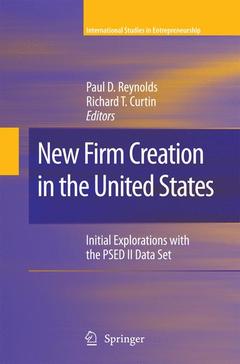Description
New Firm Creation in the United States, 2009
Initial Explorations with the PSED II Data Set
International Studies in Entrepreneurship Series, Vol. 23
Coordinators: Reynolds Paul D., Curtin Richard T.
Language: English
Subjects for New Firm Creation in the United States:
Publication date: 10-2014
342 p. · 15.5x23.5 cm · Paperback
Publication date: 06-2009
342 p. · 15.5x23.5 cm · Hardback
Description
/li>Contents
/li>Comment
/li>
Entrepreneurship is an increasingly popular topic—in business research, education, practice and policymaking
Presents the most current data from the ongoing PSED project, with contributions from leading researchers in the field
Covers a wide range of topics relating to new firm creation, with an emphasis on the people who start new businesses
Supported by the Kauffman Foundation and the Small Business Administration
Includes supplementary material: sn.pub/extras




